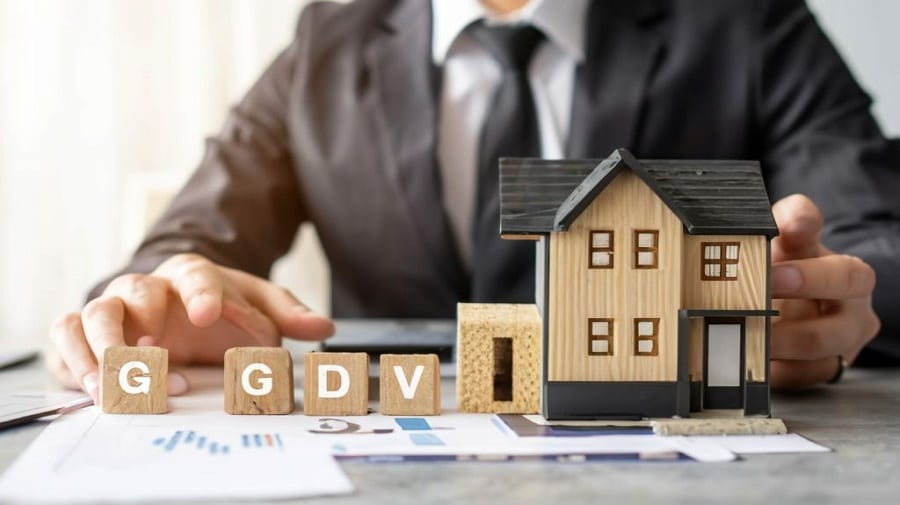Gross Development Value (GDV) is a crucial metric for anyone involved in property development and investment. But what exactly does GDV mean and why does it matter? This in-depth guide explains everything you need to know.
What is Gross Development Value?
Gross Development Value (GDV) refers to the total projected value of a property development upon completion. In other words, it is the anticipated future market value of the finished project.
GDV encompasses the cumulative value of all the individual properties or units within a development. This includes factors like:
- Selling prices
- Rental income potential
- Any additional revenue streams
For example, if a development consists of 5 houses valued at £200,000 each, the total GDV would be £1,000,000.
The formal definition provided by the Royal Institute of Chartered Surveyors (RICS) states that GDV is:
“The estimated total development cost, including costs of construction and profit for a developer or owner on completion of a project.”
Therefore, GDV factors in property values as well as development costs and profit margins.
Read more about How Long After A Viewing Should You Expect An Offer
Why is GDV Important?
Understanding and accurately forecasting GDV is crucial for several reasons:
Financial Viability
Property developers utilize GDV forecasts to assess if a potential development project is financially viable. By comparing the anticipated GDV against estimated costs, they can determine expected profitability.
Investment Decisions
Investors look at GDV projections to evaluate the potential return and risks involved. It informs decisions on which projects to invest in.
Funding
Banks and lenders use GDV to make lending decisions, as it indicates the potential security available to secure financing. Higher GDVs allow larger development loans to be sustained.
In short, GDV determines overall feasibility. It is an essential metric underpinning property development finance and investment.
Read more about Disadvantages of Buying Leasehold Property
How is GDV Calculated?
Being such a vital concept, an accurate methodology for calculating GDV is required. Common approaches include:
Comparable Analysis
Recent property sales of similar type and size in the local area are used to benchmark potential values. Adjustments are made to account for differences in factors like location, size, specification and market conditions.
For example, if comparable new-build 3-bed houses sold nearby for £250k, this provides a baseline GDV estimate.
Residual Land Value Approach
Another technique involves working backwards from the required profit target to ascertain viability. Here, GDV is a key output calculated based on the desired returns and costs.
In practice, GDV analysis utilizes a hybrid approach blending multiple methods with the expertise of skilled surveyors and developers.
Read more about First Homes Scheme
GDV vs Other Key Metrics
While being a crucial central metric itself, GDV also forms the basis of several other key property development finance metrics, including:
Loan to GDV (LTGDV) – The ratio of the development loan amount to the GDV. For example, a £3m loan on a £10m GDV project equals 30% LTGDV.
Loan to Cost (LTC) – The loan amount as a percentage of the project’s total development costs. For example, a £3m loan on a project costing £5m equals 60% LTC.
Loan to Value (LTV) – Similar to LTGDV but based on the underlying property value rather than GDV.
GDV ties all these together to assess funding potential and risks.
Don’t miss learning about Property Deal Sourcing And Deal Packaging
Conclusion
In property development, few metrics are as important as accurately assessing Gross Development Value. As the total anticipated market value of the finished project, GDV holds the key for evaluating financial viability, securing investment, and arranging financing.
While more art than science, knowledgeable developers skillfully combine market analysis, localized insights and expert judgement to forecast GDVs. This single figure unlocks the entire equation for property development appraisals.
Now that you understand the crucial GDV meaning, you have taken the first step towards smarter property development and investment decisions.
FAQs
Here are some important FAQs that you might be interested in:
Is GDV Important For Letting Out?
GDV remains a useful metric even if the end goal is to retain the finished development as rental units instead of selling. The expected rental incomes contribute to GDV along with potential future sales values.
Having an accurate GDV forecast provides a benchmark for assessing feasible purchase prices of development sites intended for rental purposes. It indicates what potential rental yield is required to cover costs.
Ongoing rental income projections also depend partly on property values. So GDV informs expected returns for rental developments.
Is There A Formula For GDV?
There is no universal formula for calculating GDV due to the many variables involved across different projects, markets and timeframes.
However, a simple formula can be:
GDV = Number of Units x Average Unit Value
So for a development of 10 houses with an average value of £250,000, the formula gives:
GDV = 10 x £250,000 = £2,500,000
In practice, more complex valuation methodologies combine feasibility analysis, market research, benchmarking of comparable properties, with professional judgement.
Can You Use GDV To Work Out Profit
Yes, once an accurate GDV forecast is obtained, expected profit can be derived by deducting costs from this.
For example:
- GDV: £2,500,000
- Total Development Costs: £1,750,000
- Expected Profit: £2,500,000 – £1,750,000 = £750,000
The profit figure can then be expressed as a percentage of GDV.
Here, £750,000 / £2,500,000 x 100 = 30% profit on GDV.
This vital metric helps assess the potential return on investment in a development. Calculating profit as a percentage of GDV is key for property development appraisals.

Daniel, a seasoned professional with over 5 years of experience in banking, property, and finance, brings a wealth of expertise to the table. This authoritative blog is meticulously curated to provide you with the most up-to-date financial insights. Delving into the dynamic realms of banking and mortgages, Daniel’s passion for finances shines through every post.










